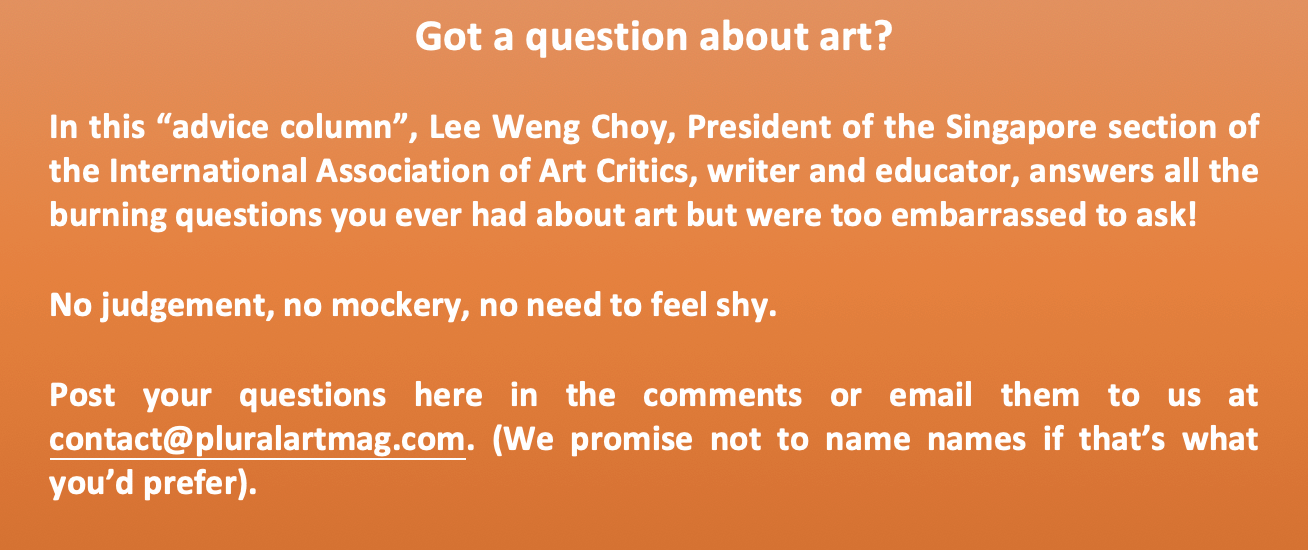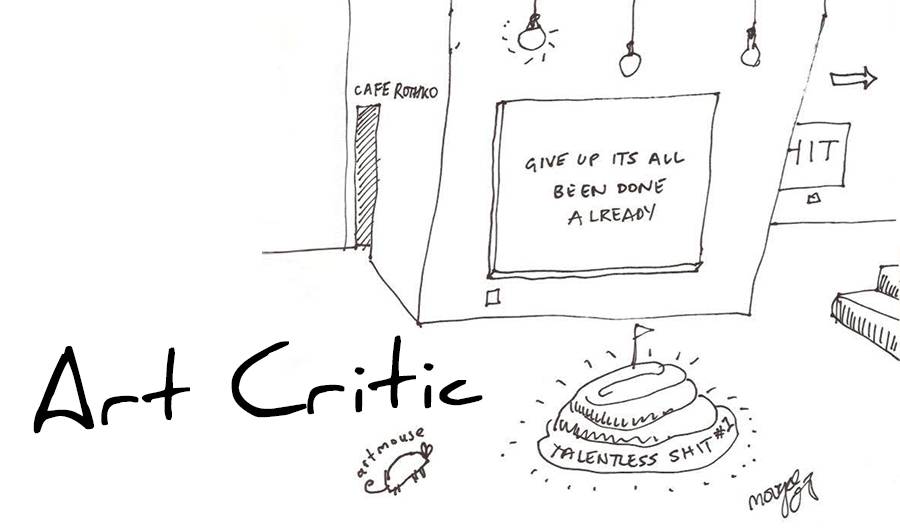
Question:
“How does an art critic deal with the conflicts that may arise after writing a negative review of an exhibition? And what about criticism of an artist or a curator who happens to be a friend?”
Answer:
Let me address the question in three parts: (1) negative criticism; (2) conflict with someone whom you’ve written about; (3) friendships in the art world.
Part 1
A long time ago, a student – who has since gone on to get her PhD and teach at university – approached me about writing a review of a relatively successful artist. She really didn’t like his show. Okay. But I suggested that, rather than simply slamming it, she focus on what she thought was best about the exhibition, and aim her criticisms at that. She took up my suggestion, offered a hard but fair assessment, and produced a good piece of art writing. If I recall correctly, the artist was receptive; that was generous of him.
What about when you’re not exactly reviewing a work or exhibition, but, for instance, making a point about bad tendencies that you’ve observed, and, let’s say you’ve expressed yourself rather sarcastically. Let’s say you’ve got a pet peeve about horribly articulated artist statements presented as part of an exhibition’s wall texts. The ones that make grandiose claims for the art, involve some references to theory or whatever is trendy, are hardly informative or helpful to the viewer, and have no apparent connection with the work on display. Curators and exhibition-organisers are as much to blame when something like this happens, as they should edit or re-write such texts, and not let them just pass as is. Though, if you mention the specifics in your writing, it would be the artist who feels the sting of the criticism.
But sarcasm can be fun! What to do? Treat all artists, curators and arts organisations gently, knowing that feelings might be hurt? Sure, making art isn’t easy, but does that mean critics should do nothing else than hand out gold stars for effort?

I happen to facilitate writing workshops regularly, but I’m loathe to prescribe any rules. Although here are two that seems like a good general guide: if you have to, punch up, not down; and be self-reflexive. If you’re dying to do a “take down” of some pompous, hypocritical, over-rated, famous artist/curator, first, take a moment for some introspection. If you as a writer are not also learning something from engaging said person’s practice, but only confirming prejudices, then maybe you shouldn’t be writing about him, her or them.
Let’s come back to my first example. Say it wasn’t a student who wanted to write about a successful artist, but an established art historian, who just happened to be visiting town, and what was on show was a group exhibition of some art school students, which she found truly awful – especially because all the artists seemed to operate on some profoundly problematic presumptions. Well, I’d suggest to her not to publish anything, but if she could, jot down some constructive notes, and I would share them with the young artists, so they might benefit from her opinion and analysis.
Or suppose a major museum puts up a show which you thought you might like – with a catchy title such as, “Are you a Man, or a Tool of the Patriarchy? Be a Man!”
Sadly, though, this turns out to be an exhibition with a bunch of male artists you respect, whom you thought would know better, but they all ended up mansplaining feminism in the “Me Too” era. What went wrong? The curation? Some strange collective lapse of judgement? Anyhow, as a male art critic, yourself, how do you take on the challenge of being critical of something you can also deeply empathise with – the importance for men to be feminist allies – but without you yourself contributing to more tone-deaf virtue signalling? Maybe, sometimes, you don’t have to express your opinion. Just listen.
Part 2
Over the years, I’ve had a few experiences where artists weren’t happy with what I wrote. Perhaps I’m lucky that it’s only been a few instances. And I’ve never had to deal with online trolls! There are so many ways that persons can be conflicted about something you wrote; I can’t begin to address the range of situations. But say the artist you wrote about is someone who matters to you. Either because of your personal relationship, or their reputation. Rather than just try to hash it out over WhatsApp, or email (which is a vast improvement over the former), may I suggest that you speak in person. If you can’t meet, then Skype, Facetime or at least speak on the phone. And when you do speak, listen. It’s not about you explaining, elaborating or defending your opinion. It’s about trying to understand what the other person is feeling. You don’t have to agree in the end, and the point is not about winning an argument. At worst, the conversation may turn into something like attending to an angry uncle during a family holiday dinner who insists on “debating” politics with you. Check out this New York Times interactive guide on how best to deal with that situation.

Part 3
Lastly, on friendships in the art world. This is a theme I’ve written about often, so allow me to rehash some points I’ve expressed over the years. Ideally, friends are the persons with whom we have our most honest conversations. We can choose our friends, unlike our families. Often we share backgrounds, sympathies and interests, but friends can also be quite different from us. Being a good friend requires consistent effort and attention, as well as empathy, generosity, and criticality – friends should call each other out on their crap. I’ve also spoken about how friendship and writing are deeply intertwined for me. Writing and being a friend both ask for honesty, good communication and self-reflection, in addition to the other qualities I’ve just mentioned. They are both about learning how to be in the world, and how to speak, listen, and live with others.
So, when it comes to writing criticism about a friend, well, I would hope that it doesn’t just come out of the blue, but out of extended conversations. And when the text is published, it shouldn’t come as a surprise to the artist or curator. The thing is, for all the bonds that are shared, friends also have disagreements. (For quite some time I’ve wanted to put together a collaborative writing project called, “Friends with Disagreements”, but haven’t gotten very far with that yet.) When friends disagree, or more importantly, when, as friends, we discuss our disagreements, we create an opportunity to strengthen our relationships as well as sharpen and develop our different positions and ideas.











